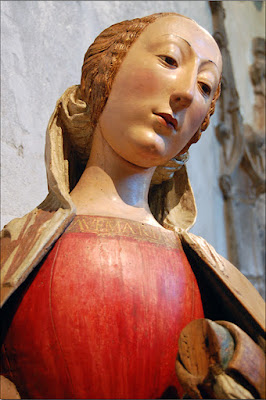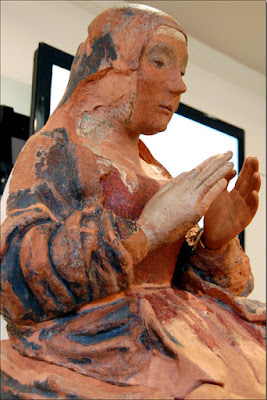[I apologize for not posting this review sooner, but my busy schedule would not allow it.]

Michela Musolino
It's hard not being impressed by Michela Musolino. As I sat listening to her sing at Recoup Lounge last Thursday night (May 12, 2011), I couldn't help but be overcome by a feeling of serenity as her hauntingly melodic voice filled the small, but intimate venue. She is truly a gifted singer deserving of great praise, not just for keeping our folk traditions alive, but because she presents them in a positive and attractive manner that can only inspire others to do the same. More than one person in the audience commented they could not believe such a talented singer was not more famous.
Billed as a "Sicilian Roots Concert," the artist's oeuvre consisted of an impressive medley of traditional and contemporary folk music influenced by the island's long, complex history. Her repertoire includes songs about love, lamentation and emigration. It also included topics more specific to Sicily, like Bonagia, a heart-rending dirge about the abduction of loved ones by Saracen pirates.
Michela Musolino and Gabriel Hermida

Musolino, also an accomplished percussionist, was accompanied by the fantastic Argentine guitarist, Gabriel Hermida. Together they formed an impressive synergy, brilliantly complementing one another and breathing new life into the music. The musicians needed no gimmicks or stunts to captivate their audience, just one guitar, one tamburello, her incredible voice and lots of passion and soul.
The musical journey began with a masterful rendition of Vinutu Sugnu, a slow, morose prison song in the cantu di sdegnu (songs of scorn) style. In it a lovelorn prisoner proclaims that he would have been better off dead than having fallen in love. The regret and heartache were captured perfectly.
She then performed the beautiful lullaby, La Vò, in honor of her friends (Matt and Desiree) who are expecting a child.
Sicily's rich musical tradition also includes passionate work-songs evoking the hardships of peasant life, so naturally they were featured in the set as well. The heartfelt Tira Murrieddu (Pull Little Mule), a carter’s serenade about enticing his love, was a perfect example of the genre. All that was missing was the beating of a mule's hooves on the ancient cobblestone.
The duo also included the modern classic, La Mafia Nun Esiste (The mafia don't exist), a sardonic anti-Mafia tune, which mocks apologists who deny the existence of la Cosa Nostra even in the wake of bombings and assassinations.
In all, they played about ten songs, ending the show with one of my all-time-favorites, Mi Votu e Mi Rivotu, a stirring ballad about agonizing love:
"Mi votu e mi rivotu sosspirannu, passu li notti'nteri senza sonnu...Lu sai quannu ca jù t' av'a lassari, quannu la vita mia finisci e mori."
[I toss and I turn, sighing; I pass the whole night without sleep...You know I'll only leave you when I die.] *
It was a wonderful performance; one I am glad I did not miss.
Speaking to Ms. Musolino after the show, I learned she would be performing again on June 1st at 8 PM at the Shrine World Music Venue at 2271 Adam Clayton Powell Blvd., NYC. Joining her on stage for a couple of songs will be the very talented Laura Campisi from Palermo. Mark the date!
Photos by New York Scugnizzo
(*) Quoted from Michela Musolino's Songs of Trinacria featuring Wilson Montuori on guitar.




























